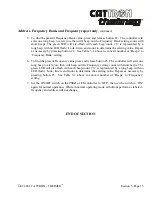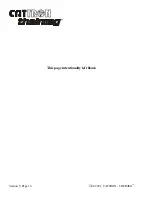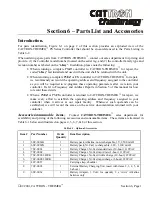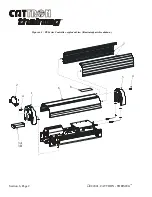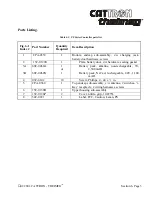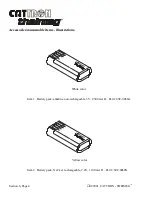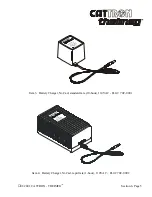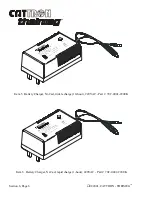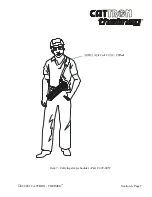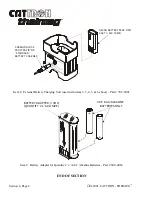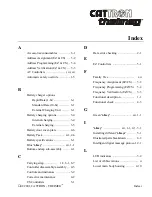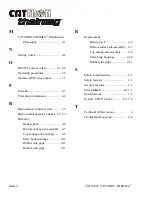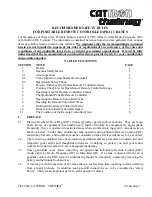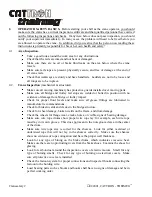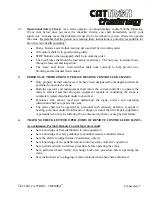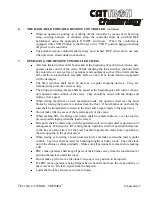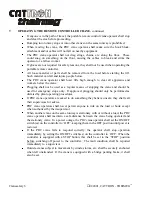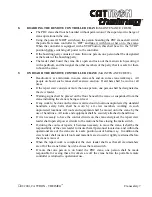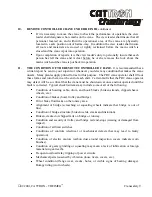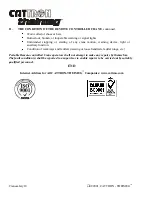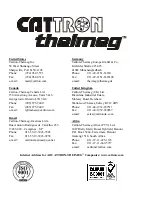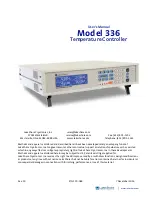
Cranesafety 2
01/2001, CATTRON
- THEIMEG
TM
2. OPERATOR SAFETY BASICS.
Before starting your shift as the crane operator, you should
make sure the crane has a current inspection certificate and that qualified personnel have carried
out the following inspections and checks. If any item below does not pass inspection, you should
notify your supervisor immediately. In many cases, the problem will need to be fixed before you
are allowed to operate the crane. In addition, did you realize that the person now reading these
instructions is primarily responsible for his or her own health and safety?
2-1
Area Inspection.
+
Take a good look around the work area for any obstructions.
+
Check that the rails are intact and not bent or damaged.
+
Make sure there are no oil or brake fluid leaks on the area below where the crane
travels.
+
Make sure rail stops are present, physically secure, and free of damage at the end of
all crane rails.
+
Check that walkways are sturdy and have handrails. Ladders are not to be loose and
all rungs are to be in place.
2-2.
Crane Inspection
(mechanical & structural).
+
Make sure all moving machinery has protective guards installed over moving parts.
+
Make sure all bridge and trolley rail stops are welded or bolted in position with no
evidence of damage from bridge or trolley impact.
+
Check for proper fluid levels and make sure all grease fittings are lubricated to
manufacturer recommendations.
+
Check for broken welds and cracks in the bridge structure.
+
Check for wheel damage, broken welds on the frame, and drum damage.
+
Check the wheels for flange wear, cracks, holes, or visible signs of bearing damage.
+
Make sure wire rope drums show proper wire rope lay; for example, each wire rope
must lay in its own groove. This does not mean in the non-grooved area in the center
of the drum.
+
Make sure wire rope size is correct for the sheaves. Look for either oversized or
undersized rope that will not lay in the sheaves correctly. Make sure the sheaves
show no evidence of rope corrugation and have the proper wall thickness.
+
Look for any type of bluing on the brake drums, which indicates excessive heat.
Make sure there are no protruding rivets from the brake shoes. Examine the shoes for
glazing.
+
Look for carbon dust around the inspection covers of electric motors. Smell for any
type of burning smells. Check for any type of burning on electrical covers. Make
sure all protective covers are installed.
+
Check the festoon system for proper connections and inspect all hooks connecting the
festoon to the holding wire.
+
Load bearing parts such as blocks and hooks shall have no signs of damage and be in
perfect working order.
Summary of Contents for i-Key
Page 2: ......
Page 14: ...Page xii 01 2001 CATTRON THEIMEG TM EZ CS AT Rx Rx Tx Tx Tx Rx Rx Rx ...
Page 20: ...Section 1 Page 6 01 2001 CATTRON THEIMEG TM This page intentionally left blank ...
Page 44: ...Section 4 Page 4 01 2001 CATTRON THEIMEG TM ...
Page 52: ...Section 4 Page 12 01 2001 CATTRON THEIMEG TM This page intentionally left blank ...
Page 68: ...Section 5 Page 16 01 2001 CATTRON THEIMEG TM This page intentionally left blank ...
Page 75: ... 01 2001 CATTRON THEIMEG TM Section 6 Page 7 Item 7 Carrying strap shoulder Part 42C 0057 ...
Page 89: ......


